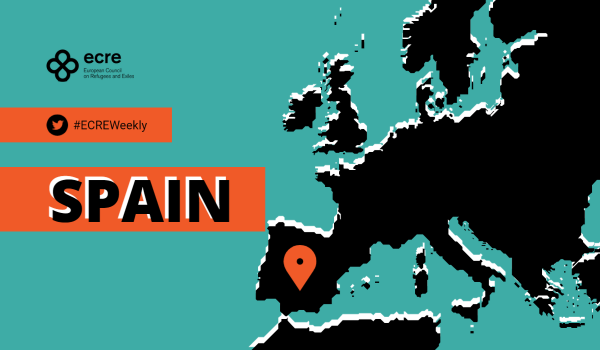An unprecedented total of 4,700 people tried to enter the city of Melilla in recent weeks, with one incident deemed the “biggest entry attempt on record”. Videos of young men who reached the Spanish side of the fence being brutally assaulted by police have provoked anger from rights advocates and prompted questions from the Spanish ombudsman. The Canary Route, used by people fleeing West Africa seeking to reach Spain, has been unusually quiet with 13 days without arrivals or rescues. Spain plans to apply the EU Temporary Protection Directive for Ukrainians to all legal residents of Ukraine, as well as Ukrainians who were in Spain in an irregular situation prior to the Russian invasion.
3,700 people attempted to enter Spanish territory via the enclave of Melilla over the week of 28 February to 6 March. A further 1,000 migrants tried unsuccessfully to climb over the fences on 8 March. The first incident, on 2 March, was the biggest entry attempt on record, involving 2,500 people. A total of 491 men successfully managed to climb two 6 metre-tall fences and make the crossing. 16 Spanish police and security officials sustained minor injuries, while 20 migrants were treated in hospital for “mostly light injuries”, the authorities said. In contrast, the Moroccan Association for Human Rights (AMDH) said fifty people were injured, three or four seriously. A local radio station published footage of men celebrating, some of them covered in blood, as they made their way to a reception centre. Reportedly however, many of the 491 were forced back to Morocco by border guards. Recordings of pushbacks generated concern among right advocates, who highlighted that “many minors” – who should enjoy particular safeguards – were sent back. NGOs also accused Spain of illegally pushing back three migrants who were found sitting on top of the fence.
A second incident on 3 March involved 1,200 people, 380 of whom made it to Spanish territory. Five days later, a further 1,000 people tried unsuccessfully to climb over the fences. The Spanish government representative in Melilla said Moroccan border guards “repelled” this third attempted crossing. These events, which took place over just several days, were remarkable given just 1,092 people managed to enter Melilla irregularly in the whole of 2021. The last mass attempt to cross the high border fence took place in October 2021, when an estimated 700 people tried to reach the Spanish enclave.
Across the three incidents, dozens of men were injured in clashes with Spanish guards. Multiple videos from Spanish television show men struggling to descend the fence before being beaten brutally and pepper sprayed. In one video, a man is kicked and beaten with truncheons by a group of police officers. Virginia Álvarez, from Amnesty International Spain, described the images as forming a sharp contrast to Spain’s preparations to welcome Ukrainians. “Is this the image we want to project? Is that how we’re going to take in people who may also be fleeing possible conflict and persecution?” Álvarez asked rhetorically. The Spanish interior minister however deemed the use of force “proportionate”. Spanish officials insist that “great violence” was used to “overwhelm the Moroccan security forces” and claimed that people used “hooks and sticks” or “threw stones”. The Spanish ombudsman, Ángel Gabilondo, is asking the government for more information on “what would appear to be a disproportionate use of force by the officers”. According to La Izquierda Diario, the people that managed to cross are held in “overcrowded, prison-like conditions” in immigration detention centres within Melilla.
The Canary Route has been unusually quiet after several busy months of rescues and arrivals. On 10 March, 56 people were rescued of Fuerteventura, the first arrivals in 13 days. Such a slow period has not been recorded since 2020, at the beginning of the first Covid-19 lockdown. During the recent quiet spell, Spain’s civil guard announced the dismantling of a Tenerife-based criminal organisation that was providing transfers from the Canaries to the Spanish mainland. The criminals were charging 1,000-2,000 euro for plane tickets and false documentation for people seeking to reach Spain after arduous sea journeys.
Spain is one of many European countries preparing to welcome Ukrainian refugees. From 10 March, Ukrainians seeking protection can apply at dedicated reception centres in Barcelona, Madrid and Alicante and at police stations throughout the country. Their applications for temporary protection will be resolved “within a maximum period of 24 hours”, the newspaper La Vanguardia says. What’s more, Spain has chosen to extend the scope of the directive to include not only Ukrainian nationals, but also legal residents of Ukraine and Ukrainians who were irregularly living in Spain to 24 February. According to El País, the latter category will amount to some 10,000-15,000 Ukrainians.
Furthermore, on 5 March, the government said they would provide accommodation to Ukrainian refugees without requiring them to request protection first. As of 10 March, more than a thousand Ukrainians had arrived in Spain.
For further information:
- ECRE, Atlantic Route and Spain: Rescues and Tragedy, Moroccan Migration Cooperation Morocco, Judge Orders Return Of Expelled Minors, Border Procedure Plans Spanish Enclaves, February 2022
- ECRE, Atlantic Route and Spain: Shift to Lanzarote and Fuerteventura, Children at Risk on Islands, Resumption of Deportation Flights to Morocco, Venezuelans Seek Refuge in Spain, February 2022
This article appeared in the ECRE Weekly Bulletin. You can subscribe to the Weekly Bulletin here.

